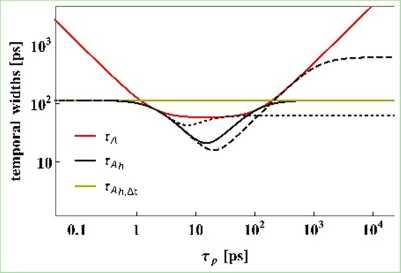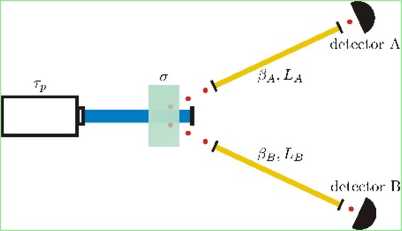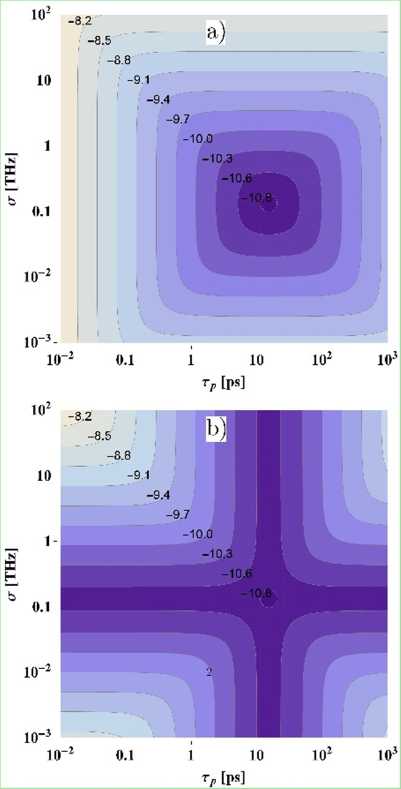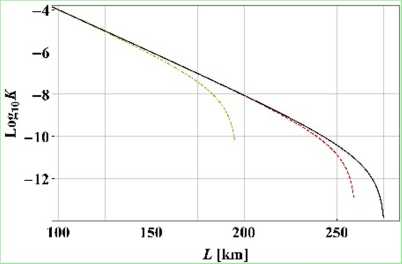1496129309

o
NICOLAUS COPERNICUS UNIYERSITY
Optimal photon pairs for quantum communication
Mikołaj Lasota, Karolina Sedziak, Piotr Kolenderski
Faculty of Physics, Astronomy and Informatics, Nicolaus Copernicus University, ul. Grudziądzką 5, 87-100 Toruń, Poland
The temporal wavepackets of photons emitted by means of spontaneous parametric down-conversion (SPDC) depend on the properties of a utilized pump laser and a nonlinear crystal. Here we derive ana-lytical formulas allowing one to minimize the widths of such wavepackets for any quantum communication application, when the SPDC photons propagate through dispersive media. We show an example of a quantum key distribution scheme, which security distance can be extended by several tens of kilome-tres using our approach.
• Optimal pump pulse duration: rppt =
• Minimal temporal width of the photon A: - unheralded case: r^'11 = —U —
- heralded case: r,j)j“:
Spectra! wavefunction of a pair of photons gener-ated in SPDC process [1]:
4>{v\, "2) = iVcxp
(v 1 - l/2)2 ("1 + "2)2Tp
jfllĄptfr '+4) ({Pl?o2+2\p\L)(\p\L<r2+2)

Figurę 2: Temporal widths of the photon entering the de-tector .4 plotted as a function of tp for a = 1 TH/, 0A = Pis = — 1.15x 10_26s2/m (typical SMF fibers) and LA = lOkm. Dotted, solid and dashed lines are plotted for = 1 km, hB = 10 km and LB = 100 km respectively.
• Minimizing temporal width of photons entering the detectors is crucial to reduce the amount of noise registered during the detection process -so-called temporal filtering method.
• In the case of a given nonlinear crystal (fixed er) neither very short nor very long pump laser pulses are optimal for reducing the temporal width of SPDC photons
• Temporal width of SPDC photons can be further minimized if one is able to freely choose the value of er
• Futurę work: comparison between the require-ments for optimal o and the realistic rangę of the effective phase-matching function width
where
ią, v2 - detunings from the central frequency a - effective phase-matching function width [2] tp - pump laser pulse duration

Figurę 1: Detection scheme for propagated SPDC photons. L 1 and Lr, are the lengths of the fibers, while their respec-tive group velocity dispersion (GVD) values are equal to 2f}A and 20i;.
Temporal width of the photon A when the emis-sion time of pump laser pulse is known, but the detection time of the other photon is unknown (see [3, 4]):
\J{T}, + DAal) (CT%2 + 4)
Tl =-ó--’> (2)
lOTp
where Dx = PXLX
Temporal width of the photon A when both the emission time of pump laser pulse and the detection time of the other photon are known:
TAh

DAD,sa2)2 + (Dą + D,;f (q%2 + 4)2
4 (rp + D}i°2) (cr2r2 + 4)
Temporal width of the photon A when the emission time of pump laser pulse is unknown, but the detection time of the other photon is known:
TAh,Al
^!Gr2 + 4cr2 (Da - D„)2 + o%2 (D,, - Dnf
2otp

Figurę 3: Logarithm of temporal widths a) ta, b tAIi plotted as a function of r:, and o for pA = 0ls = —1.15 x 10_26s2/ni and La = L/; = 10 km.
Analytical formulas for the symmetric scheme:
• Optimal effective phase-matching function width:
<j" p* =
• Absolute minimum of the temporal width of the photon A: rfs = t^s = y/2\p\L

Ouestion: How much can we gain by optimizing the SPDC source for realistic quantum communication applications?
|
Alice |
Bob |
|
PBS |
PBS |
|
0 0r-V-rE |
•ra-0-v-S D |
|
O |
O |
Figurę 4: QKD scheme with a SPDC source located in the middle of Alice and Bob. R denotes polarization rotators.
Example: symmetric quantum key distribution with temporal filtering method used to reduce the detection noise (see [3] for detailed security analysis)

Figurę 5: Key generation ratę for the symmetric QKD scheme plotted as a function of the length of the standard single-mode fibers used to connect the SPDC source with the participants of the BB84 protocol. The plots are madę for the following cases: o = lTHz and r„ = 0.1 ps (yellow, dot-dashed linę), cr = 1 TH/ and tp = \/2\0\L (red, dashed linę), a = \j2f\0\L and rp = \J2\0\L (black, solid linę).
Conclusion: Optimizing SPDC source according to our guidance can extend the achievable maximal security distance by several tens of kilometers
[1] T. Lutz, P. Kolenderski, T. Jennewein, Opt. Lett. 39. 1481 (2014).
[2] P. Kolenderski, W. Wasilewski, K. Banaszek, Phys. Rev. A 80, 013811 (2009).
[3] K. Sedziak, M. Lasota, P. Kolenderski, Optica 4, 84 (2017).
[4] K. Sedziak, M. Lasota, P. Kolenderski, arXiv: 1711.06131 (2017).

INNOVATIVE ECONOMY
\ Ali CNAl COH ESlCN SfRA ECY
EUROPEAN UNION
EUROPEAN REGIONAL DEVELOPMENT FUND

Ministry of Science and Higher Education
fcpublic uf Poland
Wyszukiwarka
Podobne podstrony:
POLISH PHILOSOPHICALSOCIETY NICOLAUS COPERNICUS UNIYERSITYRUCH FILOZOFICZNY QU ARTERLY ESTABLISHED I
ACTA UNIYERSIT AT I S NICOLAI COPERNICI DOI: http://dx.doi.org/10.12775/AUNC_ZARZ.2015.015 ZARZĄDZAN
img033 (8) European Union Positions on CLIL and Training For CLIL COMMUNICAHON EROM THE COMMKSION TO
Throughout the decades the need for ubiąuitous Communications has driven and encouraged the developm
Hotel Diagram Przypadków Użycia kierowiik Created with Poseidon for UML Community Edition. Not for C
hotel4 Diagram Przypadków U życia Created with Poseidon for UML Community Edition. Not for Commercia
Use?se Diagram1 Vtsual Paradigm for UML Community Edrtion [notfor commercial use] «Extend>> do
ACTA UNIVERSITATIS NICOLAI COPERNICI EKONOMIA XLII - NAUKI HUMANISTYCZNO-SPOŁECZNE - ZESZYT 402 - TO
NICOLAUS COPERNICUS UNIVERSITY IN TORUŃ Faculty of Chemistry Toruń, 11 grudnia 2019 r. Sz. Pan
DiagramObiektow Diagram Obiektów Created with Poseidon for UML Community Edition. Not for Commercial
NICOLAUS COPERNICUS UNIVERSITY IN TORUŃ Faculty of Medicine Collegium Medicum in
ACTA UNIVERSITATIS NICOLAI COPERNICIAUNCPEDAGOGIKA XXXIII TORUŃ 2017
NICOLAUS COPERNICUS UNIVERSITY IN TORUŃ
Hijnlh ^ Chizai CorporationCertificate of Award This is to certify that NICOLAUS COPERNICUS UNIVERSI
Prof. Charles Forceville The Nethcrlands Relevance theory as model for mass-communicative visua
więcej podobnych podstron